Thank you for visiting! By the way… any links on this page that lead to products on Amazon and other stores/partners are affiliate links Aquarium Store Depot earns a commission if you make a purchase.
Are you struggling with finding a quality Nano Reef Tank?
In this blog, we share the best nano reef offerings in the market, from all in one setups to DIY kits to make your own!
With over 25 years of experience in the aquarium hobby, I’ve assisted countless clients, hobbyists, and readers like you in finding comfort with their aquarium selection. I’ve personally tested these products in real world scenarios to determine the best nano reef tank on the market.
The Top Picks
Let’s start off with the top selections for those of you in a hurry. The red sea tops our list with their all in one aquarium while the Fluval sea offers a great value package for those wanting to try a nano reef tank.
The Candidates – A Quick Comparison
Let me list out the best nano reef tanks available and the ones who made our list for consideration. For this round up I focused on all in one tanks.
| Picture | Name | Type | Link |
|---|---|---|---|
Editor’s Choice 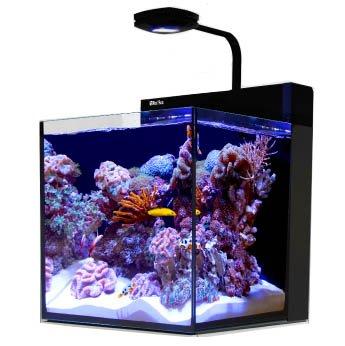 | Red Sea Max Nano |
| Click For Best PriceBuy On Amazon |
Best Value 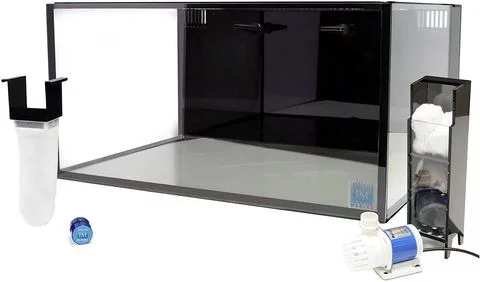 | NUVO Fusion 25 Lagoon |
| Click For Best PriceBuy On Amazon |
Budget Option 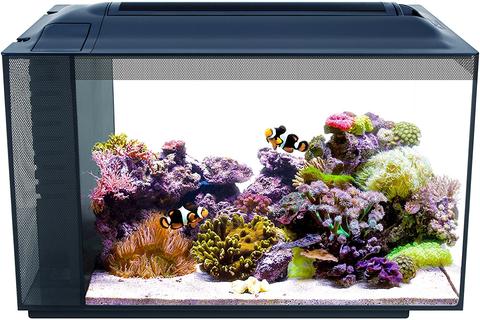 | Fluval Sea Evo |
| Click For Best PriceBuy On Amazon |
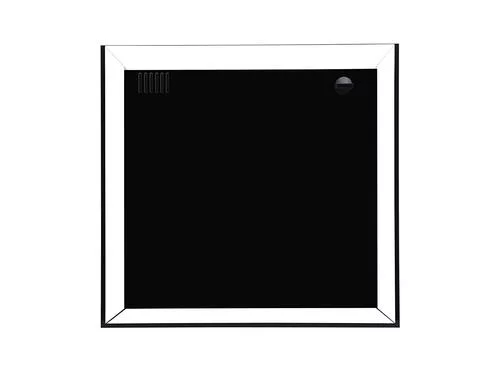 | Waterbox Nano |
| Click For Best PriceBuy On Amazon |
 | JBJ Nano-Cube WiFi |
| Click For Best PriceBuy On Amazon |
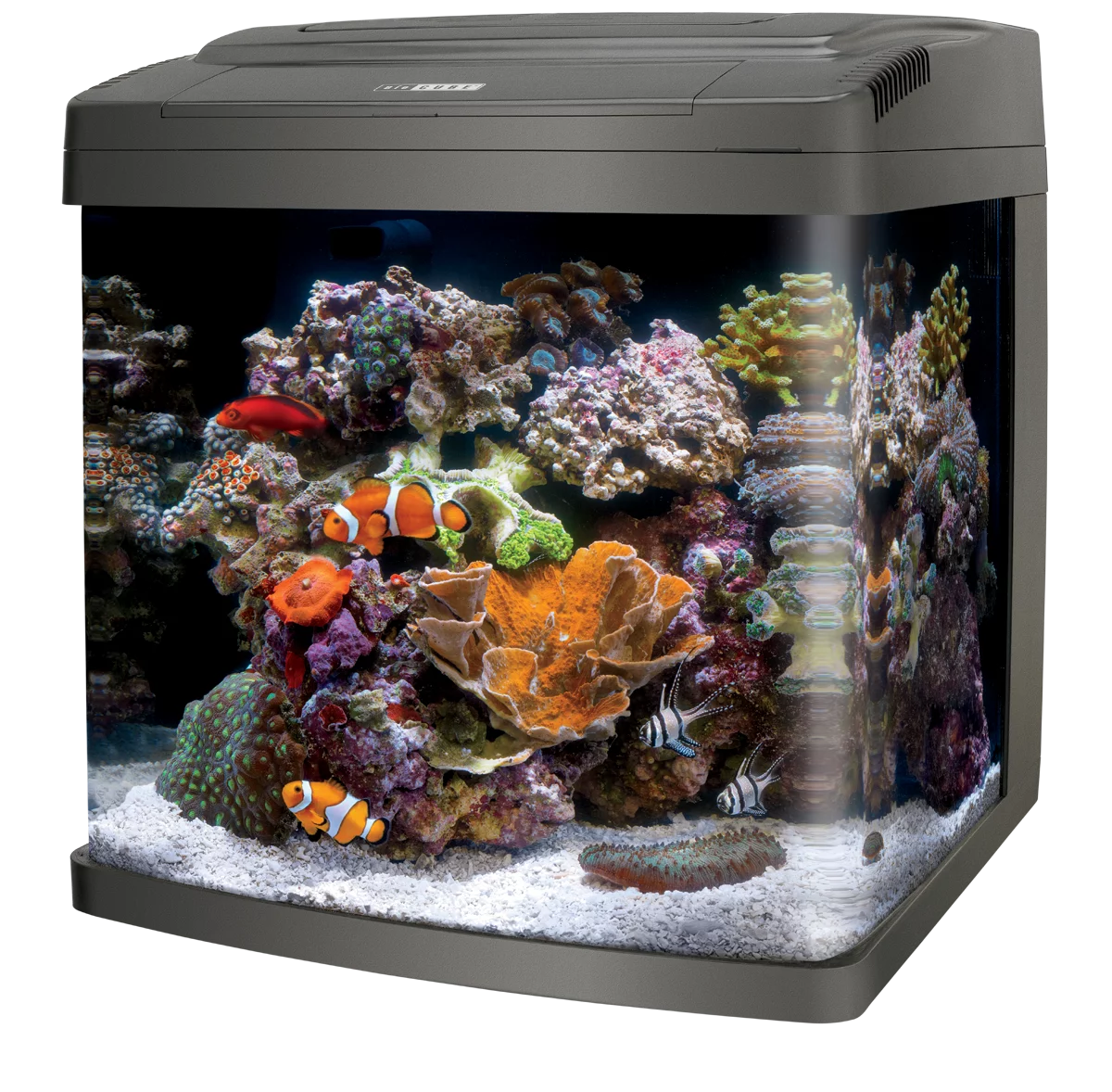 | Coralife Biocube |
| Buy On ChewyBuy On Amazon |
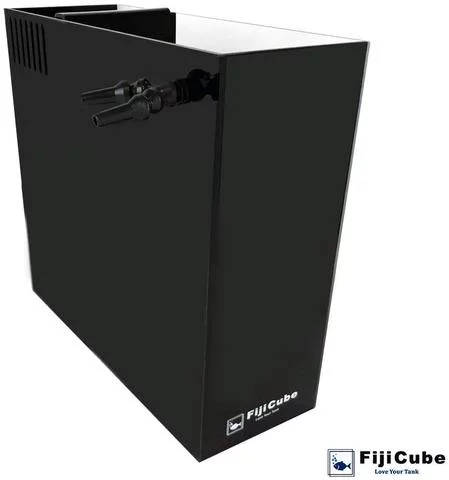 | Fiji Cube All-In-One-Kit |
| Buy On Amazon |
The Top 7 Nano Reef Tanks (2023 Reviews)
Okay so you got the must knows. Now it’s time to find out what makes these tanks so great. Time to see why they made the cut! You can also check out our YouTube Channel below and follow along with this blog post.
1. Red Sea Max
Editor's Choice
A high end plug and play reef system. Top shelf reef equipment and design
If you are looking or a top of the line aquarium kit with premier equipment, the Red Sea Max Nano Aquarium kit is where to go if you are on a higher end budget. It’s a 20 gallon aquarium that comes with high quality Red Sea 50 led light that is suitable for most corals in a nano reef system. The Red Sea Max Nano aquarium kit is equipped with features such as European built pumps, micro filter bag for mechanical, an automatic top-off unit, and a protein skimmer this comes with every single major piece of equipment you will need to run a successful reef all in a complete integrated package.
It is a full aquarium that has an easy set up and high quality nano protein skimmer. It runs day and night and is one of the high quality saltwater aquariums we recommend that comes equipped as a full kit.
Pros & Cons
- Premium Equipment
- Great Light
- Rimless
- Expensive
2. Innovative Marine Fusion 20 Pro
Best Value
Complete with pump and filter, this rimless nano tank screams value
This nano saltwater aquarium tank holds 20 gallons of water and comes is a fully equipped kit with just about everything your aquarium fish could need. The Fusion Nano 20 has plenty of room for giving your fish a fun environment and comes with a water stage filtration system. It fits perfectly on the back of the tank, well hidden and out of the way, and runs quiet. You won’t be woken up by the noise of it or hardly notice it at all.
An added bonus to this high quality aquarium kit is that it comes with a magnetic glass cleaner. It’s super easy to use and great at cleaning the glass, so you won’t have to get wet when scrubbing down the tank. It makes keeping the water quality good easy, so you don’t have to spend valuable time. Besides, who wants to contribute to poor water quality that harms your aquarium unknowingly?
Pros and Cons
- Premium Equipment
- Great Pump
- Rimless
- Expensive
- No Light
3. Fluval Evo Marine Aquarium Kit
Budget Option
The Fluval Evo is a great way to create a nano reef tank. The light is ideal for low light corals
This glass tank is great for saltwater fish. It fits nicely in smaller spaces while still giving your fish ample room to swim around and explore. The glass tank is sleek with a smooth design and made from aluminum casing. It also comes with an led lighting system for both during the day and at night. The led system has a just as easy set up so that rest of the aquarium, so you won’t have to search for help.
The Fluval Evo marine aquarium kit has a straight forward set up and features a powerful mechanical filter. It isn’t loud and won’t bother you during the day or at night, allowing your fish to have high quality filtered water without annoyance. The 3 stage filtration works day and night without aid and keeps your glass tank from growing algae as quickly. You’ll also find this tank has an easy feeding door located at the top of the tank.
Pros and Cons
- Beginner Friendly
- Great Price
- Only works for low light corals
4. Waterbox Aquarium
A classy rimless nano reef tank that won't break the bank! Great design with a well design all in one chamber
Waterbox has really shook the industry with very precise and classy glass nano aquariums. The Waterbox Nano Aquarium is a perfect saltwater tank for someone looking for a nano aquarium kit with an all in one set up. It comes with all the stage filtration system parts you need to start and it’s easy to upgrade with the space given in the all in one chamber.
This saltwater tank comes in sizes between 4 gallons and 20 gallons, shaped in a cube with 5-6mm thick glass. The back of it is smooth and well covered so you won’t have to look at awkward parts or an ugly set up. It’s complete with a built in water overflow system and 3 stage filtration system chambers as well. During the day and night, you’ll hardly notice the sounds of the three stage filtration system or water pump.
The rimless design of this waterbox aquarium makes it appealing and sleek, easily blending into your home decor. There is plenty of room to landscape the aquarium to your liking. It doesn’t have a cover, but as long as you don’t have other animals that might get into it, you’ll be fine.
Pros and Cons
- Great Build Quality
- Cube Shaped
- No Light
5. JBJ Nano Cube Wifi 28 – All In One With Light At A Reasonable Price
This nano reef tank is powered by a 40 watt LED system that can house mid and low light corals
The new JBJ Nano Cube 28 Wifi is the successor to the well known JBJ Nano Cubes and a great upgrade for a larger cube aquarium. This new model features a wifi enabled 40W LED lighting hood with 3 stage filtration system baskets that are easily removable. The main cost savings with this aquarium is the wifi-enabled LED lights which is easy to control with the app and will handle most light and medium light demand corals.
The Wi-Fi system is easy to use and the wavemakers make this a true self run system. It’s one of the better all-in-one systems out there. The price just keeps it lower on this list.
Pros and Cons
- 40W LED System
- WiFi Enabled
- Smart Phone Controlled
- Expensive
- Curved Glass
6. Coralife BioCube
The BioCube started the nano tank craze. It continues to be a component system and upgraded with LED in its latest generation
The BioCube is what created this category in reefing. This cute little LED biocube nano tank is great for putting on a nightstand or another small space. It measures 15” x 16.75” x 17.5” long, wide, and high. This small square won’t hold a hugely diverse collection of fish, but it will give your few fish a nice little home to play in.
This saltwater nano tank features a 24 hour timer to replicate a natural day and integrated LED lights. There is a built in 3 stage filter and an easy flip lid that nicely covers the top of the aquarium. The 3 stage filtration system and led lights really make this kit great.
Pros and Cons
- Brand Name
- Readily Available
- Lots of Upgrades Available
- Expensive
- Underpowered Lights
- Curved Glass
7. Fiji Cube All In One Kit
A DIYers special! The Fiji Cub AIO Box turns any standard aquarium at a pet store into an all in one system that can run a nano reef tank
This fiji cube kit is available in sizes ranging from 10 gallons to 40 gallons and all the way up to 75 gallons. It includes a plumbing kit with an adjustable nozzle and a filter sock holder. Well constructed, this reef tank kit features just enough space for all the filter media you’ll need.
This all in one kit can be put into your aquarium to step up your tank game. As long as you purchase the right size kit for your tank, you’ll be able to deck out your fish’s home and make your tank look just a little classier. It has a reliable filtration system, submersible pump, and other features to up your game.
Pros and Cons
- Cheap
- Converts Any Standard Aquarium
- Underpowered Pump
The 5 Things You Must Know Before Buying a Nano Reef Tank
I showed you a quick list of the best out there. Before I go into detail on each tank, Let me go through the 5 things you must know before you venture into the Nano Reef Tank journey.
#1 It’s Cheaper to Setup than A Traditional Saltwater Reef Aquarium
Most hobbyists and fish keeping experts will recommend starting out with a larger aquarium typically anywhere from a 40 – 75 gallon. This is because a larger tank will have more water volume for added stability. However, not everyone can afford a tank this size (or have the space for one) so a nano reef tank is a legitimate consideration for those with small budgets.
A good aquarium kit will include features such as a filter, submersible pump, and a protein skimmer. Some may even have LED lights to provide light day and night.
While a nano reef aquarium is still expensive compared to a freshwater tank, you will not need to shell out thousands of dollars on a small setup. With proper preparation and care, one can successfully keep a smaller nano reef and often times produce a stunning aquarium that rivals the looks of larger aquariums – at only a faction of the cost!
So what exactly is it?
Well, let’s define it here as many hobbyists will break out the nano reefs into two categories:
- Nano Reef Tank – Aquarium that is 40 gallons of water or less
- Pico Reef Tank – 5 gallons of water or less
We are going to discuss nano reef tanks in this post only. Pico tanks are the subject of an advanced aquarist nature and definitely not for the faint of heart, so it’s best to wait for the pico tank of your dreams until you know what you’re doing. So now that the term nano reef tank has been defined, let’s talk about why they are cheaper.
Let’s break it down into several reasons:
- Minimalistic setup
- LED lights are cheap in a nano
- Nanos are far easy to break down and move
The first part are the setups. Nano reef tanks will usually have a bare bones type of setup. There is usually not a sump involved which means there is no plumbing to deal with. A simple powerhead or aquarium wavemaker is used for flow and flow tends to be less complicated because nano tanks will often be coral reef type dominant vs. mixed.
Protein skimmers are not necessary, though many hobbyists will use them. When a protein skimmer is used a hang-on back protein skimmer is typically used. Due to the small size of the tank often times a hobbyist will opt for purchasing distilled or RODI water from a local fish store instead of investing in a RODI system. Your electrical bill will also be cheaper as well since you will not be using that much equipment.
Budget Option
Compact and great for smaller tanks. This is the best unit if you live in an apartment or dorm
Lighting is another cost savings. One of the most expensive pieces of equipment for larger tanks are the lighting systems required for higher intensity and the number of LED lights needed for longer tanks. With nano reef tank kits, the lighting cost is cost down drastically.
Some nano reef kits will actually come with features for lighting and this lighting is plenty for soft coral or fish only with live rock setups. Even for a high end lighting system, you will likely not spend more than $200 on lighting for a nano reef tank (and in most cases much less than this). Chinese Black Box lights are often used for nano tanks as they are well sized and have the light intensity to accommodate all setups and are cheap.
Mobility is another great benefit of a nano reef. These aquariums often are placed in tight areas like a desktop, bedroom, or on a stand in a living room. Because they are able to be moved easily, one can move them throughout the home to suit the home decor changes you make over time. They are also one of the aquariums that you can safely place upstairs.
With larger systems, one has to consider the structural support of the home to ensure it can support the weight upstairs. If your home does not have the proper weight support for a large system, it is likely that you would need to increase the support or consider a different location. There is also water spills to consider with a larger tank upstairs.
#2 It’s Considered an Advanced Level Aquarium
I will open and honest and say that a nano reef tank is more suited for an experienced aquarist. There are three reasons for this:
- Stability with salinity
- Stability with temperature
- Stability with nutrients
The main reason why there is lack of stability is due to having less water volume in the tank. Evaporation in particular, is extremely brutal to a nano reef tank. Every other day freshwater top-off is usually needed to keep salinity parameters in check. Sometimes, the task is a bit overbearing so you will often see an auto top off system (ATO) installed in a nano reef tank.
Temperature is another concern, especially if you live in a warmer climate. Temperatures can swing during the summertime especially if you live in a home without air conditioning. When in doubt, a cooler room is easier to deal with than a warmer room in the home. You should also utilize an open tank setup. Your lighting system must be suspended above the aquarium either with a suspension kit or the suspension mounts your LED light system comes with.
A canopy is a no-no for a nano reef tank. You can ensure proper control of temperature with a controller like an Ink Bird controller. This controller will guard against aquarium heater failure – the #1 reason for tank crashes.
Protect your investment with this heater controller. An excellent choice for small tanks. WiFi models now available!
Nutrient stability is the last issue with a nano reef tank. Because you do not have a larger volume of water, weekly water changes are a must for a nano reef. In a larger system, it is reasonable to perform bi-monthly or monthly water changes. There are even cases where other hobbyists go months after establishing a complete nitrogen cycle in the tank.
Unfortunately, this is not a reality in a nano reef tank. You will not have enough volume and space to establish a complete system and with the stability issues – it is a best practice to continue weekly water changes even after running the desk successfully for some time.
The good thing, however, is that water changes are a breeze in a nano reef tank because you changing a very small amount of water volume.
Because of the inherent stability issues with a nano reef tank, it is not uncommon to spend extra time monitoring the tank. Leaving your tank unattended for more than two days can be disastrous if something would happen like a heater failure.
It is best to know a friend in the hobby if you are planning to be out of town to watch your tank. You can use my earlier blog post of a list of hobby clubs near you to find other hobbyists in your area.
#3 Your Options for Fish are Limited in This Type of Setup
Due to the limited amount of space and stability issues of a nano reef, your options for fish are very limited. When thinking about fish to put into a nano reef tank, we need to consider the following:
- What is our fish’s natural temperament?
- How large does the fish get?
- How hardy is the fish?
- Are the fish reef safe?
When thinking about the fish’s natural temperament, we really want to focus on getting a fish that has a mellow temperament. This is likely going to be the only fish or one of the only fish in the tank. So if you are considering placing more than one fish in the tank, we really want to purchase a peaceful fish.
If you are happy with only one fish in the tank, we can do that as well. But we have to keep in mind any invertebrates that you want to add – especially shrimp. Some fish like damselfish are known for attacking shrimp when space is lacking. It may be best to consider avoiding any damselfish if you are considering shrimp.
Your fish’s size is the next consideration. We really want to purchase a fish that is going to get no larger than 3 inches for a nano reef tank. This means no large fish like Tangs. I do know some hobbyist placing a tang in larger nano reef tanks like a 40 gallon tank in the short term, but if you are new to nano reefs or do no have the money for a future upgrade I would not consider a Tang for the sake of the fish’s livelihood.
The hardiness of your fish is another important factor. A nano reef tank will have parameters fluctuate no matter how much try to prevent it. Because of that, you want to make sure you have the most resilient fish you can buy. Look for tank bred fish or fish labeled as easy to keep or hardy.
Reef safe fish is our last consideration. It actually many not be a factor if you are considering a fish only with live rock setup, but nevertheless you do not want to house a known coral picker in your tank. Your space is small and you will not have many corals.
If you have a coral picker, it will not take very long for your fish to wreck havoc on a small tank. This means that even borderline reef safe fish like dwarf angels are out of the consideration for a reef tank. It’s best to take the risk with a larger tank with fish like that as you can remove the picker before things get our of hand.
So now that I have outlined the important factors, let’s talk about fish that fit this criteria. Several fish from my top 10 best saltwater fish for any reef tank post make great nano reef tank fish. You can check out that post for further info, but here are several fish that would fit well in virtually any nano reef tank setup:
Best Choice For Reef Tanks!
Clownfish are hardy, full of personality, and are safe for all corals. They are an icon for any saltwater tank
Keep in mind when it comes to stocking fish in a nano reef tank, we want to lightly stock our tank. You are dealing with a small amount of volume, limited space which will increase aggressiveness, and limited bioload capacity from having a smaller tank. I know that movement and personality of the fish is the big draw with aquariums, so this takes me to the next section of our article.
#4 It’s More About Your Corals Than The Fish
As we covered earlier, one of the issues that nano reef tanks face is their lack of size. The very thing that makes them an attractive option for small spaces also puts them at a disadvantage when it comes to stability. Chemistry and temperature changes happen quickly in a nano reef tank. Because of this some corals are going to be ill suited for a nano reef tank. We talked about fish earlier. So what are some good choices when it comes to corals?
Because we know that our fish choice and stocking is limited, we really should focus on corals. Picking a variety of the correct corals will add lots of color and movement to a nano reef tank that will mitigate the lack of space and stocking options. I will break down the consideration factors below:
- Hardiness
- Movement
- Aggressiveness
- Variety
Hardiness is our number one factor when it comes to selecting corals in our nano reef tank. We want corals that can take a few parameter swings. This makes soft corals the prime candidate for nano reef tanks.

The movement of corals will create a flow in the tank and make the aquarium pop. Without the movement, you are going to have very little moving life in the tank because you will likely have one or two fish in the tank. Lots of movement sometimes comes with added aggressiveness.
Because of our lack of space, aggressiveness is a bigger consideration than in larger tanks. Spacing aggressive corals too close to each may cause coral deaths, especially with corals with strong stingers like some LPS corals. The preference would be to house corals that are known for living in dense spaces.
Variety is our last consideration. We want to have a variety of colors available in our corals because we will not have many fish. The good thing is with the availability of aqua cultured and fragged corals, the variety of colors are ever increasing with this hobby.
#5 Patience is a Virtue
Any experienced hobbyist will tell you that patience is key when it comes to reef aquariums. It is even more pronounced in a nano reef tank.
In a larger system, you can sometimes get away with rushing things because you have the buffer of a larger volume of water. That is not the case in a nano reef aquarium. Take the time to cycle your tank correctly, ask a ton of questions, and do not impulse buy. Any mistake or impulse purchase gone bad will get ugly very quick in nano reef aquariums.
How To Setup (3 Main Setups for Success)
So now that I have gone through the selection factors for corals in a nano reef tank, let’s talk about setups. I’m going to focus on coral type tanks as those are the easiest ones to explain. I will go through the following:
- The Bullet Proof Setup
- The LPS Setup
- The SPS Setup
1. The Bullet Proof Setup
A bullet proof setup in the best nano reef tanks would comprise of easy-to-care corals such as soft corals, polyps, zoas, and mushrooms. These types of corals are great choices for a nano reef tank as they are tolerant of a few fluctuations in chemistry and temperature in the tank. Not only are these corals hardy, but they will also provide much needed motion in the tank.
Here are a few examples of corals that would make good additions in a bullet proof setup:
- Finger Leather Corals – Kenya Trees & Sinularia
- Mushroom Corals – Actinodiscus, Ricordea, and Rhodactis
- Polyps & Zoanthids (Zoas)- Mix and Match Freely
Editor's Choice!
Zoas come in multiple colors and easy to care for. The perfect choice for nano tanks!
Finger leather corals are fast growing and great for filling vertical space while mushrooms, polyps, and zoas can fill the mid and low spaces. Their rapid growth will cause them to fill out a nano reef within a few months.
The main advantage with corals like these is they have a weaker stinging ability compared to other corals. This means that they are able to be in close proximity to each other without too much stress. There is always some type of territory combat in a reef aquarium, but soft corals are less likely to kill each other off and you are given more leeway for to make up for mistakes.
The other great thing about a bullet proof setup is your lighting requirements are pretty simple. Virtually any type of LED fixture available for a nano reef tank is going to provide ample lighting for these corals and the lighting solution will be easy on the wallet.
I have not even mentioned the color variety available – especially for zoas. I have seen many beautiful Zoa only nano reef tanks that are absolutely stunning. It is very easy to get addicted to Zoa collecting and building up your own mini water garden.

2. The LPS Setup
While not as hardy as a soft coral setup, a LPS setup can provide one of the most stunning looking aquariums. With many LPS corals to chose from, they provide a variety of colors and motion in the tank.
The main issue with LPS is their aggressive nature. Careful spacing will need to be provided especially when it comes to Hammer, Frogspawns and Torch corals. These corals are know to kill off other neighboring corals if placed to close to each other.
Here are a few examples of corals that would make good additions in a LPS setup:
- Frogspawn
- Hammer
- Torch
- Blastomussa (Blasto)
- Acanthastrea Lordhowensis (Acan Lord)
- Micromussa Coral (Micro Coral)
- Candy Cane Coral
- Trumpet Coral
Because of the more aggressive nature of Frogspawns, Hammer, and Torch corals, it would be best to only have a select few of these. In smaller nanos, it is probably best to avoid these corals because of their aggressive nature and their size, or consider a Frogspawn/Hammer coral only setup. and all Euphillya setup is a great way to mimic an anemone tank look.
Candy Canes, Acans, and Micro corals, however, are more peaceful. Your lighting is going to need to be more intense than with the bullet proof setup, but any reef grade LED should work for an LPS setup.

3. The SPS Setup
Small Polyps Stony Corals or SPS corals are a very popular reef tank setups in the hobby. If you have been to any of the big reefing forums, you will see that many of the feature tanks on those forums are dominated by SPS setups. They are the hardest of the three setups I have outlined.
Here are the reasons why SPS are usually not a good idea for a nano reef tank:
- Very delicate corals
- Very combative
- Requires intense lighting
Any sudden change in water or light can suddenly kill multiple colonies in an SPS tank. Their combative nature is known in nature. What typically happens is that two colonies will grow over time and eventually touch each other – which causes a die off in both colonies.
The lighting requirements of SPS corals are also very high, which means the intensity of your lighting in a small space might increase your temperature to deadly levels.
So while they are not a good fit for a nano reef tank, many hobbyist will still place SPS in corals in the tank. I am not going to get into harder-to-keep SPS corals as that is the subject of a more advanced coral keeping post for another time.
I want to concentrate on the hardiest SPS corals out in the market that would be appropriate if one desires to keep SPS corals in their nano reef tank. When looking for SPS corals in a nano reef tank, we want to find SPS corals that are hardy and tolerant of subdued lighting conditions.
Here is the list of the best SPS corals for a nano reef tank:
- Seriatopora hystrix (Bird’s Nest Coral)
- Pocillopora
- Echinophyllia aspera (Chalice Coral)
What I am doing here with these recommendations is replicating the big draws of an SPS setup (branching and plating corals), but selecting SPS corals that are on the hardier and less light intensive end.

Both bird’s nest and pocillopora will gave you that branching look of an Acropora coral while the chalice coral will give you a look similar to a Montipora coral.
While they are on the hardier end of the SPS care spectrum, it is all relative. This type of setup is far from a bullet proof setup. SPS corals are still an advanced level coral and you would still need to keep a watchful eye on water parameters.
Closing Thoughts
I hope that this article helped provide clarity for any questions you had about keeping a nano reef tank. The best nano reef tanks are amazing when running well and are more favorable than larger systems. With careful planning and some good maintenance habits, you can enjoy a nano reef tank of your own. Thanks for reading and leave a comment to let us know which kit you chose!
- About the Author
- Latest Posts
I’m thrilled that you found Aquarium Store Depot! Here you’ll find information on fish, aquariums, and all things aquatics related. I’m a hobbyist (being doing this since I was 11) and here to help other hobbyists thrive with their aquariums! I adhere to a high quality Editorial Process and Review products with real life field usage and practical analysis.

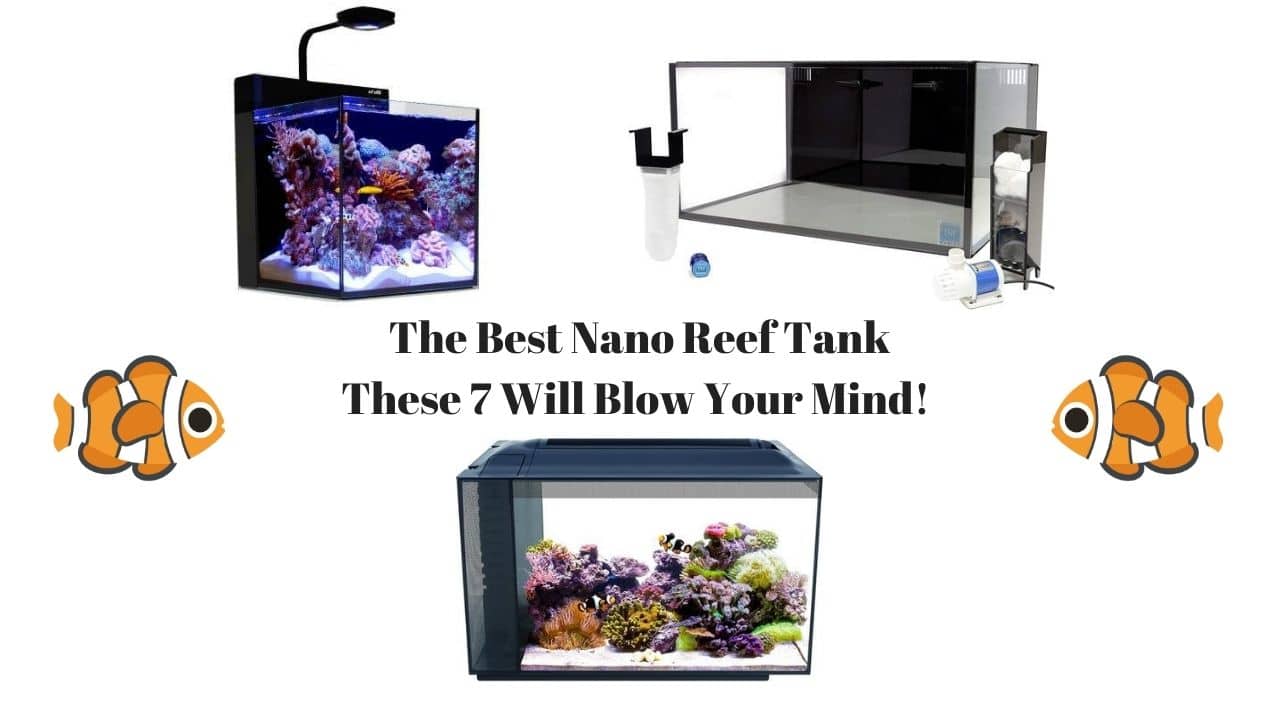


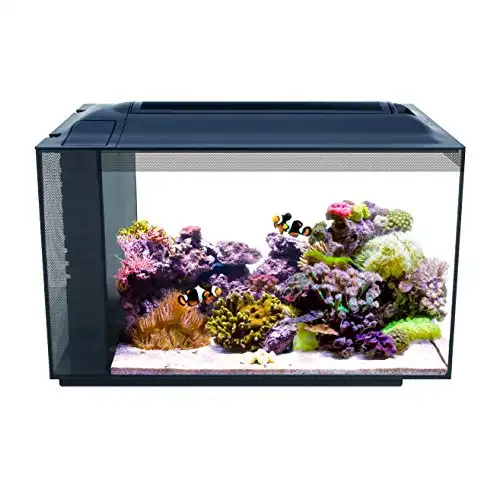



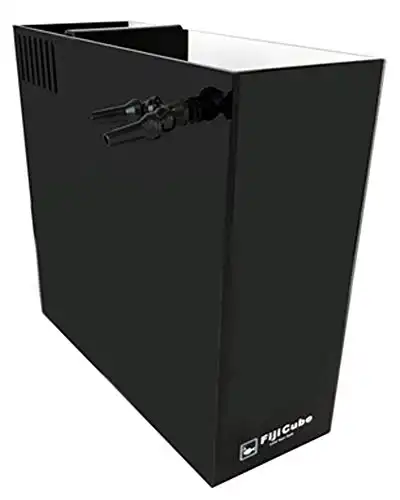

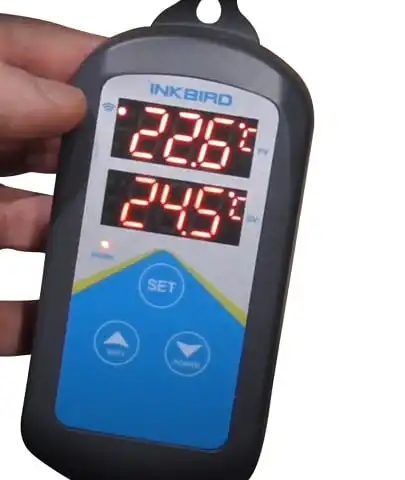

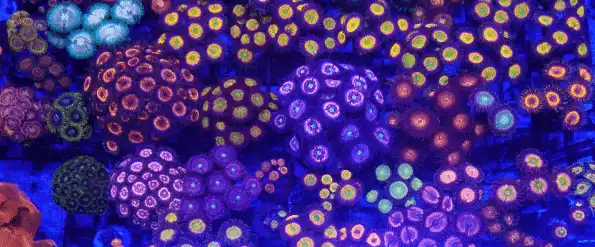




In a larger system, sometimes you can get away with rushing things because you have the buffer of a larger volume of water. That is not the case in a nano reef tank.
Informative and well written. Great advice. I’ve just started a 20 gallon setup. – softies, acans, mushrooms, pair of clowns. I know it’s not zaktly a nano but a beautiful challenge anyway. Much and many water changes often is what I do. Skim heavy, tons o rock and keep it cool as I can. (75 ish)
You’re advice is most appreciated. Cheers from Toronto!
Hi AR,
A fan is probably best. A chiller is probably going to be overkill. You will want to control the fan with a temperature controller. Temperature stability is one of the killer issues with nano tanks because the water volume is so small. I would suggest moving the tank to the coolest area of your apartment. It’s easier to work with an area that is too cold than too hot, though ideally you have the area where the tank is as controlled as possible.
question. In just got a 10 gallon and the question is temperature!! would I need a small chiller or a hang on back fan would do the work! I live on an apartment but AC is not always on. The tank is a nuvo 10